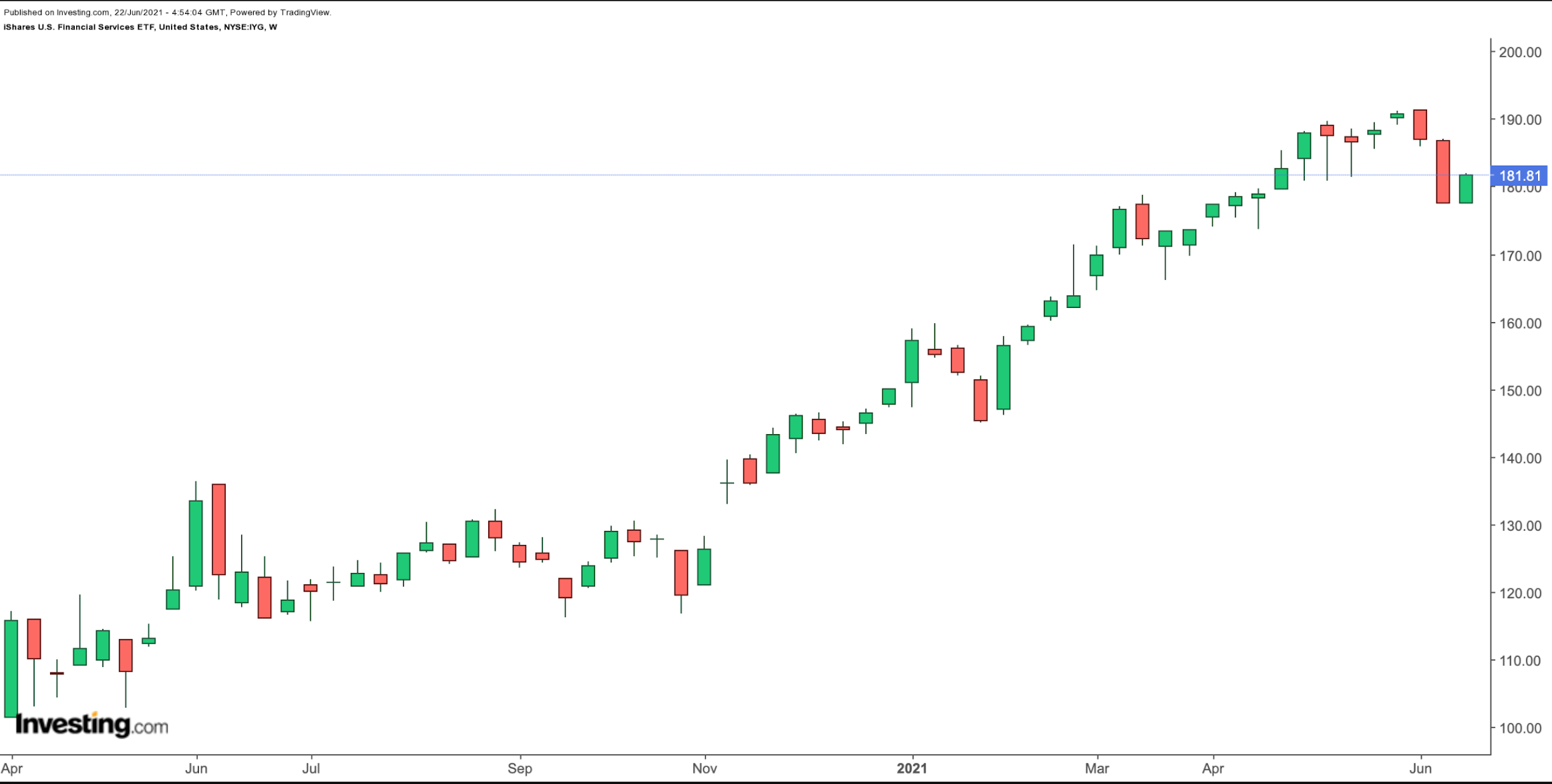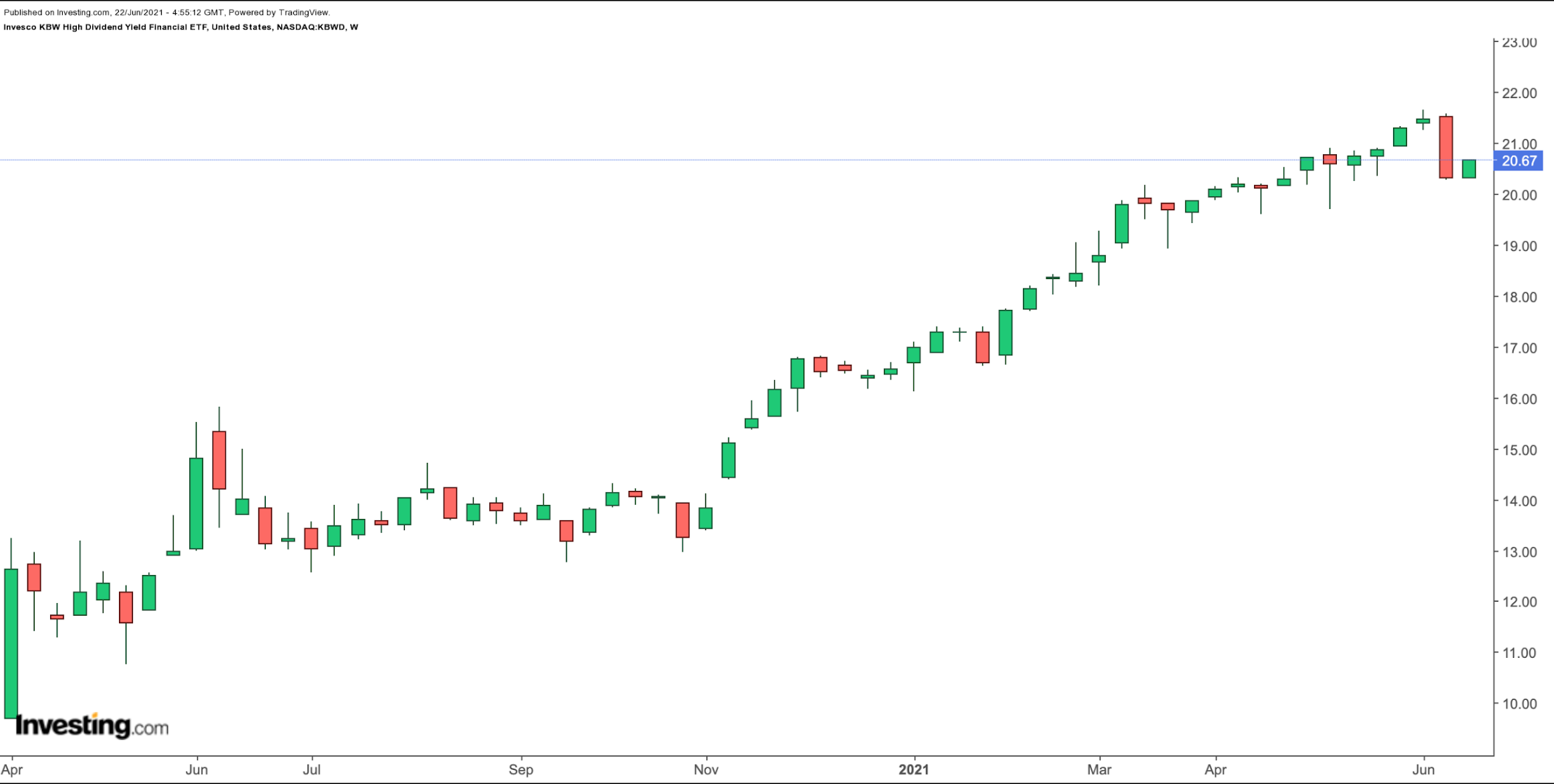Financial stocks, including bank shares, have come under pressure recently. For instance, the Dow Jones Financials Index, which hit an all-time high June 7, have lost about 5% since then. Year-to-date, the index is up about 18%.
Similarly, the Dow Jones US Banks Index, which hit a multi-year high on June 3, is down about 10% since then. So far this year, however, the index is up more than 22%.
Analysts are debating the reasons behind this recent decline in banking shares. On the one hand, the Fed has signalled two rate hikes in 2023. Increasing interest rates typically help improve profit margins of banks.
We can evaluate a bank’s balance sheet to arrive at its net interest income (NII) by deducting interest paid from the total interest earned. Therefore, a bank’s interest income usually improves when interest rates go up.
Yet, many banks have a hybrid business model. They generate a significant amount of their revenue from non-interest bearing activities, like brokerage services, banking-related service charges, credit card-related fees, their own trading profit and losses, and mortgage-related activities. As a result, a bank’s non-interest income is usually dependent on other factors that affect the economy and the bank’s operating environment.
Readers who pay attention to technical charts could also conclude that there could be more pain for many financials in the days ahead. Given the returns in the past 52 weeks, more profit-taking could be in the cards.
Therefore, today we introduce two exchange-traded funds (ETF) that potential investors might want to research with an eye to buy in the second half of the year, possibly at cheaper prices.
1. iShares US Financial Services ETF
Current Price: $181.81
52-Week Range: $115.62 – $191.37
Dividend Yield: 1.55%
Expense Ratio: 0.42% per year
The iShares US Financial Services ETF (NYSE:IYG) provides exposure to US financial services equities, including investment banks, commercial banks, asset managers, credit card companies and securities exchanges. The fund tracks the Dow Jones US Financial Services Index.

IYG, which started trading in June 2000, has 103 holdings. The top 10 stocks make up about 57% of net assets, which stand at $2.3 billion. In other words, it is a top-heavy fund.
Banks lead with 42.13%, followed by diversified financials (39.60%) and software and services (17.82%). JPMorgan Chase (NYSE:JPM), Visa (NYSE:V), Mastercard (NYSE:MA), Bank of America (NYSE:BAC) and Wells Fargo (NYSE:WFC) top the list of current holdings.
So far this year, the ETF has returned more than 20% and hit an all-time high in early June. Trailing P/E and P/B ratios are 25.14 and 2.24, respectively. A potential decline toward $170 would improve the risk-return profile.
2. Invesco KBW High Dividend Yield Financial ETF
Current Price: $20.67
52-Week Range: $12.57 – $21.65
Dividend Yield: 6.86%
Expense Ratio: 1.24% per year
The Invesco KBW High Dividend Yield Financial ETF (NASDAQ:KBWD) invests in US financial shares with competitive dividend yields. The focus is on small-capitalization firms like asset managers, mortgage real estate investment trusts (mREITs) and clearing banks. The fund is rebalanced and reconstituted quarterly.

KBDW, which tracks the KBW NASDAQ Financial Sector Dividend Yield Index, has 40 holdings. The fund began trading in December 2010, and net assets stand at $460.6 million.
Among the leading names in the roster are investment managers FS KKR Capital (NYE:FSK), Newtek Business Services (NASDAQ:NEWT), REITs Chimera Investment (NYSE:CIM) and Apollo Commercial Real Estate Finance (NYSE:ARI).
So far this year, the fund is up about 24.5% and hit a multi-year high on June 10. Trailing P/E and P/B ratios stand at 16.19 and 1.55, respectively. Passive-income seekers whose portfolios can accommodate an ETF with a focus on small-cap financials and high expense ratios could consider researching the fund further. A potential decline toward $19 or below would improve the margin of safety.
